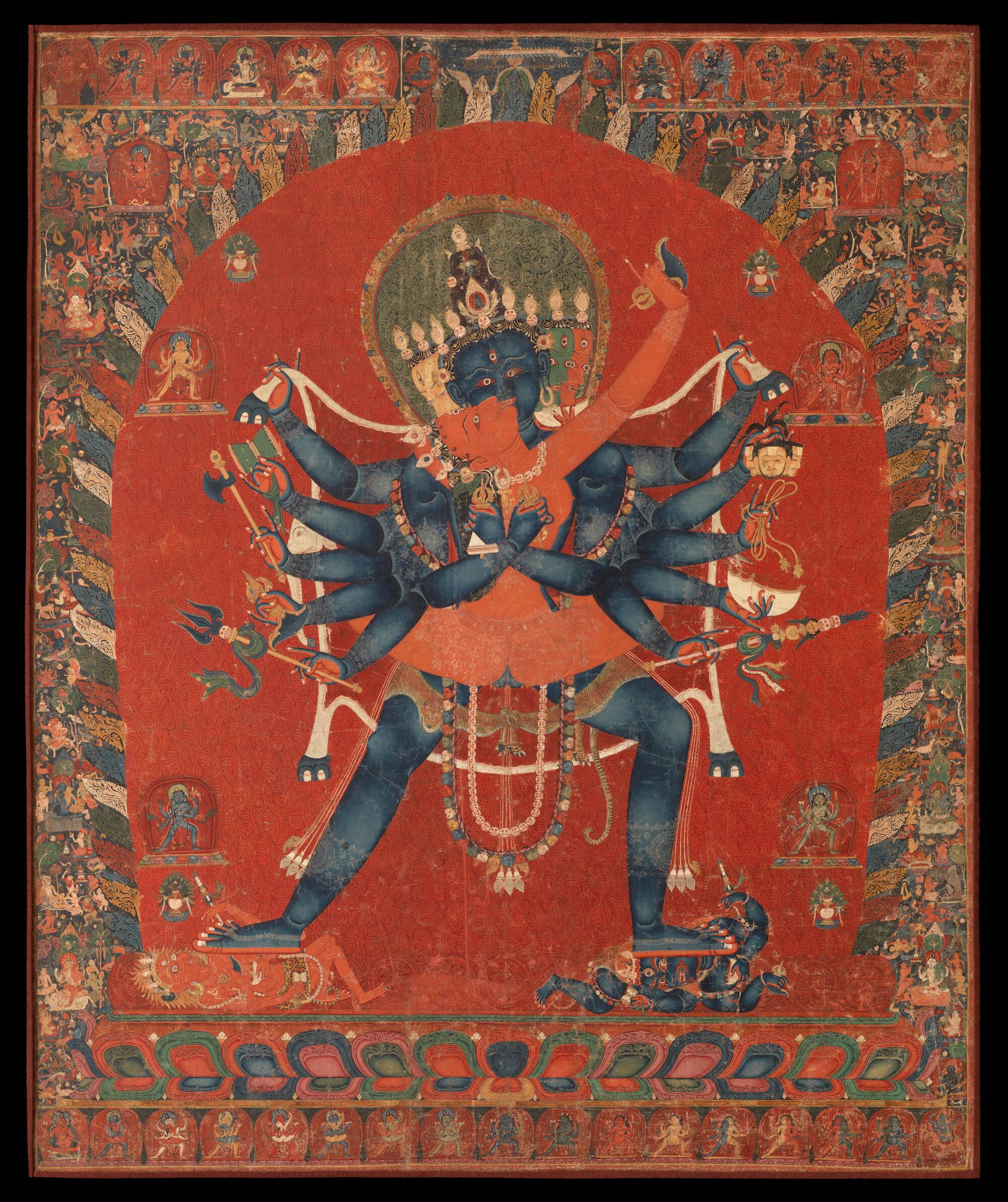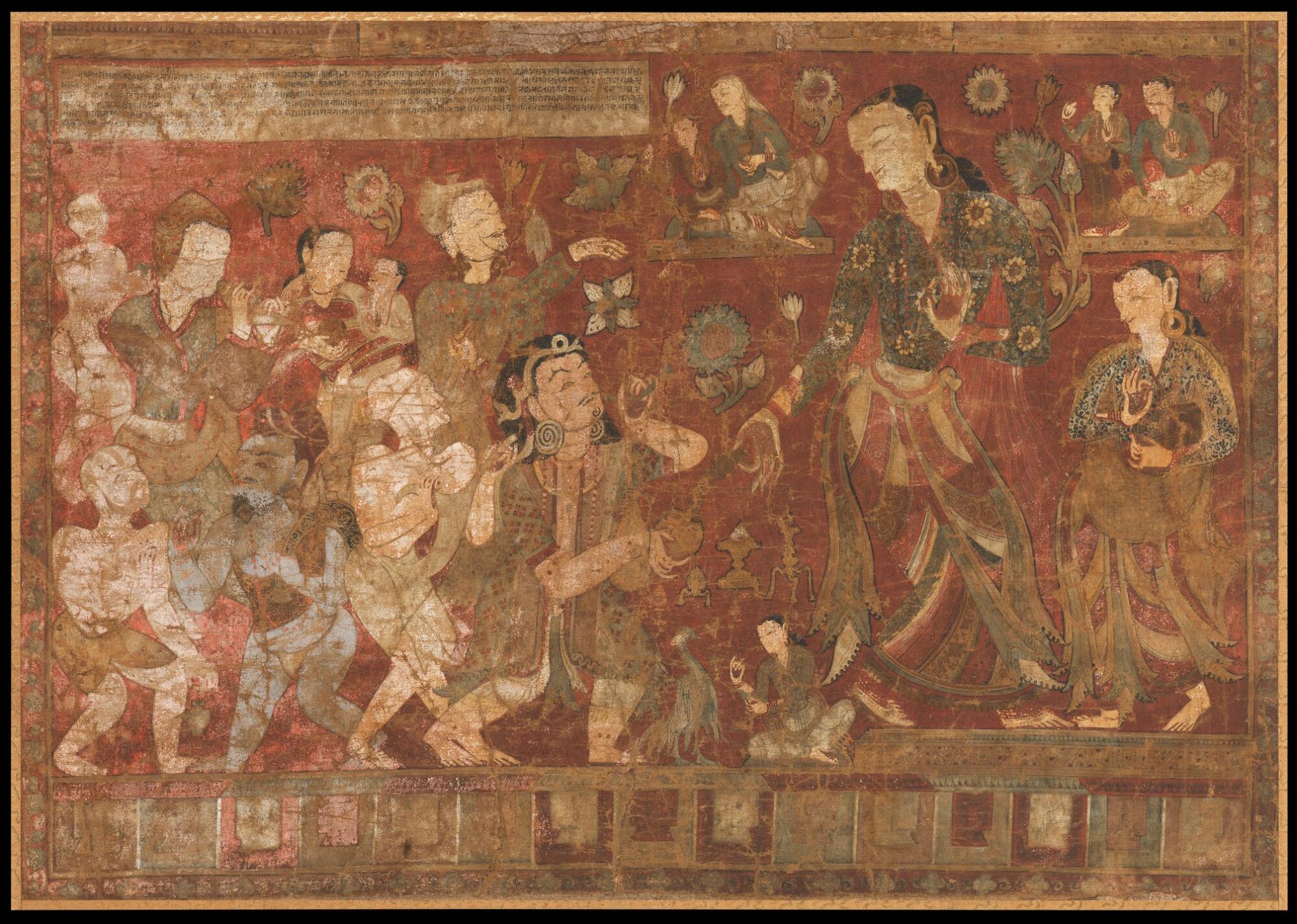“Realms of the Dharma: Buddhist Art Across Asia” is a large and engaging presentation that includes some of the most splendid sculptures and paintings in the permanent collection of the Los Angeles County Museum of Art. It’s great to see these works again.
Most of the art was packed up around eight years ago in preparation for the demolition of the museum’s original campus and construction of a new permanent collection building. The current offering of around 180 objects, installed in the temporary exhibition spaces of the Resnick Pavilion, is a version of what was then sent on tour, presented in 2018 at Mexico City’s incomparable National Museum of Anthropology. (LACMA Deputy Director Diana Magaloni was former director there.) Subsequent planned travel to art museums in Texas and the Pacific Northwest were derailed by the COVID-19 pandemic, so the work went back into storage. It has been unavailable for hometown public viewing for a very long time.
Siddhartha Gautama is accepted by most scholars as the historical figure Shakyamuni Buddha, or sage of the Shakya clan, who was born in Nepal and lived in India around the 5th century BC. Representations of the religious teacher started out as nearly abstract symbols a few thousand years ago — a starburst shape inside a spiraling whorl, for example, which configures an emanation of light within an eternal flow. A Bodhi tree might signal the sacred place where Buddha’s deep insight into enlightenment occurred, or a drawn or carved footprint would be suggestive of following a path.

“Jina Buddha Vairochana,” India, Kashmir region, circa 725-50; brass and silver.
(Museum Associates / LACMA)
But no biographical texts emerged for several hundred years after his death. Legend and religious doctrine intertwined over centuries, splintering and reconfiguring and taking on new dimensions as they encountered scores of established cultures across South and Southeast Asia and beyond — Daoist philosophy in China, say, or Shinto religion in Japan. Eventually, figurative representations took shape. Needless to say, as they proliferated in what are modern Sri Lanka, Pakistan, Myanmar, Thailand, Indonesia, Cambodia, Korea and more, Buddha took on a variety of forms. LACMA has scores of fine examples, large and small.
Sometimes, as in an exquisite 8th century brass and silver cast from Kashmir, just 16 inches tall, he is seated with legs crossed and fingers entwined, counting earthly elements like fire and water being absorbed into the mind. In Tang Dynasty China he sits isolated in regal splendor, like an emperor carved in timeless white stone atop an elegantly draped cushion.
In the next room, a sturdy Burmese Buddha wearing a transparent garment of reddish lacquered wood raises an oversize right hand in a jumbo gesture of peace, extending an open left hand that seems caught in mid-motion. (There are scores of symbolic Buddhist hand gestures, called mudras.) A life-size columnar figure carved from sober gray schist, familiar from the Gandhara region of Pakistan, likewise raises a peace mudra, but here the cascading folds of his tunic’s drapery signal a military history of Greco-Roman interactions dating to the expansionist conquests of Alexander the Great.

“Buddha Shakyamuni,” Burma (Myanmar), circa 13th century; lacquered wood.
(Christopher Knight / Los Angeles Times)
Any religion that’s thousands of years old and practiced in innumerable places will be beyond complicated in doctrine and nuance, and Buddhism is no exception. Deciphering them here is a scholar’s task. The names of individual artists are also mostly lost to us. However, what all these different iterations share stylistically, regardless of whatever embellishments surround the Buddha, is a sense of stable, enduring calm at the core. At all times idealized in his physical features, he’s the living embodiment of the irresistible force paradox — an immovable power and an unstoppable object all at once.
Also on view are ritual tools, like a jewel-encrusted crown, ceremonial knives and a lovely offering cabinet adorned with paintings of fierce, glowering demons that caution anyone who might dare to disturb whatever the cupboard holds. Back off!
Sculptures and paintings of poets, lamas, deities and especially bodhisattvas — earthly helpers who have postponed their own entry into nirvana, where suffering disappears, in order to help others find their way — are nearly as numerous and varied as Buddha Shakyamuni himself. Some are wildly extravagant, proliferating heads and arms into delirious phantasms of multiple personality and manifold temperaments.
An astounding 15th century painting on cotton cloth is a fiery image of sexual coupling between deities, a crimson female figure with both legs wrapped around an ashy blue man. He stands on one straight leg with the other athletically bent, forming a robust stance designed to stabilize an ecstatic act of energetic intercourse.

“The Buddhist Deities Chakrasamvara and Vajravarahi,” Tibet, circa 15th century; pigments on cotton.
(Museum Associates / LACMA)
Like fluttering wings, his 12 elegantly splayed arms wield an array of esoteric symbols around her excited body, while her single arm raises what appears to be a ritual blade high overhead. His flaming-eyed face is frontal, hers is overlaid in perfect profile. The shrewd composition abuts their lips, so that they are just about to touch in a kiss. Chakrasamvara, the blue-man emblem of compassion, is being embraced by his consort, Vajravarahi, bright red symbol of wisdom, in a spectacularly explosive display whose arrested design seems intended as a spur to deep meditation. They are on the brink, and so, it is to be hoped, are we.
The installation of “Realms of the Dharma” is pretty straightforward. The first section introduces Siddhartha Gautama. A few wall texts outline basic Buddhist principles and the religion’s two major forms — Theravada (or monastic) and Mahayana (sort of “Buddhism for all”). From there, most objects are clustered by simple chronology and the region where they were made. That organizational scheme for such varied works of art is standard for permanent museum collections.
It’s rather unusual at LACMA, though, given the timing. Earlier this month, previews were held of the empty new building for the permanent collection, the David Geffen Galleries, explicitly designed to replace chronology and geography with art clustered by theme. Press materials for “Dharma” suggest it’s a thematic package, with the exhibition as a means to learn about Buddhism. That reduces art to illustration, but happily the installation doesn’t come across that way.

“Probably Shakyamuni, the Historical Buddha,” China, Tang Dynasty, circa 700-800; marble.
(Christopher Knight / Los Angeles Times)
Art museums are great places to learn about art — about how it’s made, by whom and why — but not so great for religious education. “Realms of the Dharma: Buddhist Art Across Asia” and its handsome scholarly catalog, written by LACMA curator Stephen Little and former associate curator Tushara Bindu Gude, are good at that. But would an American art museum ever do a show on the theme of, say, “Transubstantiation: Catholic Art Across Europe and the United States,” in order to teach the diverse subtleties and dynastic refinements of a belief in the conversion of bread and wine into flesh and blood? Probably not. Aside from trying to wedge such wildly disparate Catholic artists as Fra Bartolomeo, Paul Cézanne, Tsuguharu Foujita and Andy Warhol into a single coherent exhibition, reducing art to illustration just undermines it.
The temptation to frame Buddhist art that way is surely a function of the religion’s unfamiliarity, its “exoticism,” except in shallow pop culture terms. Of the roughly half-billion Buddhists worldwide, less than 1% of Americans identify with it. According to a fascinating March study from the Pew Research Center, Buddhism is today second only to Christianity in experiencing especially large losses in adherents globally, with former followers switching to other faiths or, more often, now expressing no religious affiliation at all. The majority live in California, a primary entry point for Asian immigration to the United States, but barely 100,000 Buddhists are estimated to practice in Los Angeles.
Also useful for museum audiences for a permanent collection show would be some acknowledgment of complex issues around the history of this sacred art’s ownership. More than one LACMA work has been contested as stolen, including an impressive 15th century painting from Nepal of an important Buddhist spiritual master named Vanaratna. LACMA bought the painting in 1977, when collecting standards were very different than they are now. The wall label, without making a definitive declaration, would be an ideal place to introduce the important subject of case-by-case provenance research, but the subject is ignored.

“The Mahasiddha (Great Adept) Vanaratna (1384-1468) Receiving Initiation From Sita Tara,” Nepal, 1469; pigments on cotton
(Museum Associates / LACMA)
“Realms of the Dharma” will remain on view for a year, closing in July 2026. That means LACMA’s Buddhist masterworks won’t be in the Geffen building when it debuts in April next year, or anytime soon after that. (Architect Peter Zumthor is testing paint glazes for some of the Geffen’s all-concrete walls, although a final decision on whether to add color has not been made.) The show is sensitively installed in Resnick. Given the art’s nearly decade-long hiatus from L.A., it’s worth visiting more than once during the next several months, before it disappears again.
‘Realms of the Dharma: Buddhist Art Across Asia’
Where: LACMA, 5905 Wilshire Blvd., L.A.
When: Through July 12, 2026; closed Wednesdays
Admission: $23-$28; discounts for youths and seniors
Info: (323) 857-6000,www.lacma.org

